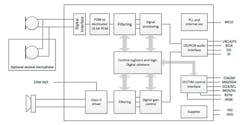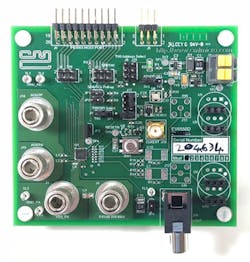With all of the understandable attention being given to high-performance multimedia coder/decoders (codecs) for smartphones, music systems, and other “more sophisticated” applications, it’s easy to forget that many audio products need high-quality performance for voice only—not high-fidelity music—along with low-power operation and small size.
Such situations are often “always on” and include intercoms, security-alarm panels, home appliances, digital assistants, voice-controlled equipment, and even glass-break detection, to cite a few cases. At the same time, the availability of low-cost, high-performance MEMS-based microphones means that many existing codecs designed for electret microphones may no longer be a good fit in terms of interface or power requirements.
That’s where the CMX655D from UK-based CML Microcircuits can help (Fig. 1). This tiny, audio-focused codec supports single or dual MEMS microphones, with parallel processing of both data streams to maintain phase alignment between their two channels. On the output side, its efficient, 1-W, mono Class-D amplifier with programmable filtering and digital gain control drives differential audio outputs for a filterless speaker. A separate single-ended, analog, line-level output function is also provided for a headphone. The 4- × 4-mm, 24-lead VQFN IC interfaces to serial buses via an SPI/TWI control interface.
1. CML Microcircuits’ CMX655D audio codec is designed for applications where voice-only performance is critical. It supports a pair of MEMS microphones, and includes a 1-W Class D amplifier as well as a line-level output.
The CMX655D supports conventional telephony and HD voice (300 Hz to 3.4 kHz, and 50 Hz to 7 kHz bandwidths) and audio bandwidths up to 21 kHz, with 16-bit sampling rates of 8, 16, 32, and 48 ksamples/s, and operates from a single 1.8- to 3.6-V supply. As with most codecs (and even most multifunction ICs), current consumption depends on which of its many internal functions are enabled and which modes are engaged. Here, it ranges from 60 µA in standby with the main clock enabled and sourced directly from an external clock (200 µA if the clock is sourced directly from the internal PLL), up to 2 mA with stereo record channels using analog microphones and the main clock directly sourced.
Efficiency when driving a 4-Ω load to 0.5-W output is 91%, while THD+N is 1% and SNR is 81 dB, both at 48 ksamples/s. For the line-level output when delivering 0.25 mW into an 18 kΩ load, THD is 0.25% and SNR is 76 dB.
2. The associated EV6550D Evaluation Board facilitates exercising the codec’s various registers, functions, and modes.
In addition to the comprehensive 76-page datasheet, the available EV6550D Evaluation Board can help exercise the IC’s functions and features (Fig. 2). It includes sockets to support digital MEMS-microphone evaluation boards and has connections for full evaluation of Class-D amplifier performance, an on-board 24.576-MHz clock, and on-board supply regulators that operate from a single 5-V supply.



